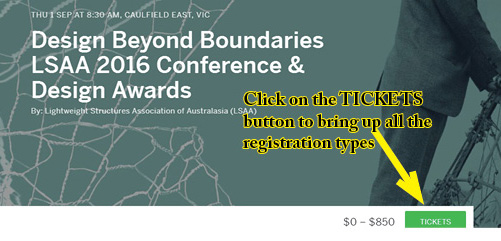Conference Program and details of Keynote & Public Lecture Presentations
These details can be downloaded HERE (PDF, 3Mb)
Summary:
Day 1 Thursday September 1st 2016
Keynote address Nicholas Goldsmith "Shape Making or Formfinding"
Session: Reflections on the Contribution of Frei Otto
Session: Project Focus
Public Lecture Nicholas Goldsmith "From Mass to Membrane"
Conference and Design Awards Presentation Dinner
Day 2 Friday September 2nd 2016
Keynote Address Ron Van Sluijs "Stadia Roof Topology through Design Methodology"
Session: Experimentation and Digital Systems
Afternoon: Design Workshop
Keynote Address – Nicholas Goldsmith
Shape Making or Form Finding?
Often design professionals conflate the process of shapemaking with the more deliberate form finding approach. This lecture will discuss the differences in the design process between these two approaches. It will examine historical traditions of both approaches and look at Frei Otto and his physical modeling approach as an example of the Form Finding process, how it examines material intelligence to set in motion an iterative approach where the end result is discovered and not known beforehand. Examples of the work of FTL will be used as descriptive case studies to illustrate the different aspects of membrane envelopes including ETFE foil cushions, tensile membranes, and cable nets.
Public Lecture – Nicholas Goldsmith
From Mass to Membrane
This follows afternoon tea on Day 1. Members of the public should join the Conference at the Faculty of Art Design and Architecture (MADA) Monash University, Caulfield Campus, Building G Theatre 1.04 at approximately 16.10 for a start at 16.15. Questions follow at 17.30
See Location notes HERE
If we look at a historical evolution of architecture from the massive pyramids of Egypt, to the framed structures of Greek/Roman construction, to the lighter Gothic vaulting, to eventually Modern architecture of the 20th century, we see a continuous almost linear progression from solid mass constructions to framed buildings of glass and steel. Today we are in the early steps of moving from glass and steel structures to diaphanous skins of membrane and foil structures. These new materials incorporate inherent technologies and the aim is to understand how these technologies will affect our spatial experiences and in the process explore lightness as a visual, physical and sustainable approach. Mass to Membrane is our human architectural journey; can we use less material, be more sustainable, and help reduce our carbon footprint on the planet we call earth? Can this linear progression become one of the keys in a more sustainable tomorrow?
Keynote Address – Ron van Sluijs
Stadia roof typology through design methodology
The large urban scale of stadia mean the structure often simultaneously dictate the form and the architecture of the venue though for the large span stadia structures only a limited number of typologies can be identified. It’s a challenge to methodically select the best fitting structure while maintaining a fresh and different aesthetic language. By illustration of various case studies this talk shall elaborate on a number of structural stadia roof typologies, both lightweight and heavy, and how these were developed architecturally and structurally.















